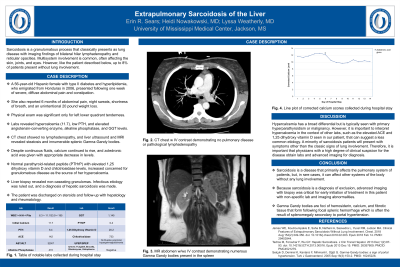Monday Poster Session
Category: Liver
P2547 - Extrapulmonary Sarcoidosis of the Liver
Monday, October 23, 2023
10:30 AM - 4:15 PM PT
Location: Exhibit Hall

Has Audio

Erin Sears
University of Mississippi Medical Center
Flowood, MS
Presenting Author(s)
Erin Sears, 1, Heidi Nowakowski, MD1, Lyssa Weatherly, MD2
1University of Mississippi Medical Center, Flowood, MS; 2University of Mississippi Medical Center, Jackson, MS
Introduction: Sarcoidosis is a granulomatous process that classically presents as lung disease with imaging findings of bilateral hilar lymphadenopathy and reticular opacities. Multisystem involvement is common, often affecting the skin, joints, and eyes. However, up to 8% of patients present without lung involvement.
Case Description/Methods: A 56-year-old Hispanic female with type II diabetes, who emigrated from Honduras in 2006, presented following 1 week of diffuse abdominal pain and constipation. This presenting episode was preceded by 6 months of abdominal pain, night sweats, shortness of breath, and an unintentional 20 pound weight loss. Initial physical exam was significant only for tenderness in the left lower quadrant. Her labs demonstrated hypercalcemia, low parathyroid hormone, elevated angiotensin-converting enzyme, and elevated alkaline phosphatase and gamma glutamyl transferase levels. Upon admission, the patient received IV fluids, and endocrinology was consulted. A computerized tomography (CT) scan of the chest, liver ultrasound, and magnetic resonance imaging (MRI) of the liver were also ordered. The CT chest showed no pathologic lymphadenopathy. MRI liver and liver ultrasound were significant for liver steatosis and innumerable Gamna-Gandy bodies in the spleen, for which hepatology was consulted. Despite continuous fluids, the patient’s calcium continued to rise, and she received zoledronic acid to which her levels appropriately responded. Further lab work demonstrated normal parathyroid-related peptide with elevated 1,25 dihydroxy vitamin D and chitotriosidase levels, which strengthened evidence for granulomatous disease as the source of her hypercalcemia. A liver biopsy was obtained, and the pathology report described non-caseating granulomas. Infectious etiology was ruled out, and a diagnosis of hepatic sarcoidosis was made. The patient was discharged with a steroid prescription and follow-up with hepatology and rheumatology.
Discussion: Hypercalcemia has a broad differential but is often seen with primary hyperparathyroidism or malignancy. However, it is important to interpret hypercalcemia in the context of other labs, such as the elevated ACE and 1,25 dihydroxy vitamin D seen in our patient, that can suggest a less common etiology. A minority of sarcoidosis patients will present with symptoms other than the classic signs of lung disease. Therefore, it is important that physicians with a high degree of clinical suspicion for the disease obtain labs and advanced imaging for diagnosis.
Disclosures:
Erin Sears, 1, Heidi Nowakowski, MD1, Lyssa Weatherly, MD2. P2547 - Extrapulmonary Sarcoidosis of the Liver, ACG 2023 Annual Scientific Meeting Abstracts. Vancouver, BC, Canada: American College of Gastroenterology.
1University of Mississippi Medical Center, Flowood, MS; 2University of Mississippi Medical Center, Jackson, MS
Introduction: Sarcoidosis is a granulomatous process that classically presents as lung disease with imaging findings of bilateral hilar lymphadenopathy and reticular opacities. Multisystem involvement is common, often affecting the skin, joints, and eyes. However, up to 8% of patients present without lung involvement.
Case Description/Methods: A 56-year-old Hispanic female with type II diabetes, who emigrated from Honduras in 2006, presented following 1 week of diffuse abdominal pain and constipation. This presenting episode was preceded by 6 months of abdominal pain, night sweats, shortness of breath, and an unintentional 20 pound weight loss. Initial physical exam was significant only for tenderness in the left lower quadrant. Her labs demonstrated hypercalcemia, low parathyroid hormone, elevated angiotensin-converting enzyme, and elevated alkaline phosphatase and gamma glutamyl transferase levels. Upon admission, the patient received IV fluids, and endocrinology was consulted. A computerized tomography (CT) scan of the chest, liver ultrasound, and magnetic resonance imaging (MRI) of the liver were also ordered. The CT chest showed no pathologic lymphadenopathy. MRI liver and liver ultrasound were significant for liver steatosis and innumerable Gamna-Gandy bodies in the spleen, for which hepatology was consulted. Despite continuous fluids, the patient’s calcium continued to rise, and she received zoledronic acid to which her levels appropriately responded. Further lab work demonstrated normal parathyroid-related peptide with elevated 1,25 dihydroxy vitamin D and chitotriosidase levels, which strengthened evidence for granulomatous disease as the source of her hypercalcemia. A liver biopsy was obtained, and the pathology report described non-caseating granulomas. Infectious etiology was ruled out, and a diagnosis of hepatic sarcoidosis was made. The patient was discharged with a steroid prescription and follow-up with hepatology and rheumatology.
Discussion: Hypercalcemia has a broad differential but is often seen with primary hyperparathyroidism or malignancy. However, it is important to interpret hypercalcemia in the context of other labs, such as the elevated ACE and 1,25 dihydroxy vitamin D seen in our patient, that can suggest a less common etiology. A minority of sarcoidosis patients will present with symptoms other than the classic signs of lung disease. Therefore, it is important that physicians with a high degree of clinical suspicion for the disease obtain labs and advanced imaging for diagnosis.
Disclosures:
Erin Sears indicated no relevant financial relationships.
Heidi Nowakowski indicated no relevant financial relationships.
Lyssa Weatherly indicated no relevant financial relationships.
Erin Sears, 1, Heidi Nowakowski, MD1, Lyssa Weatherly, MD2. P2547 - Extrapulmonary Sarcoidosis of the Liver, ACG 2023 Annual Scientific Meeting Abstracts. Vancouver, BC, Canada: American College of Gastroenterology.
